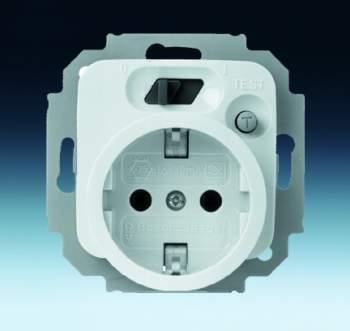Unfortunately, with two wires, we only have the L and N wire.
The L conductor, which has a potential (voltage) of approx. 230V in relation to the N conductor, which N conductor should have a potential close to ground, i.e. 0V, as a neutral conductor. The N conductor goes through several connections and finally connects (at least it should be connected) to the building earth. This conductor N, if it is connected to the grounding pin, then acts as a ground, i.e. if for some reason there would be a breakdown in the device (insulation damage) such that the power supply from the L conductor would connect to the housing, then the current flowing from the housing to the connected pin with N, the protection should trip (burnout of the fuse link or trip of the S-type circuit breaker).
When we power a device that has a grounding pin from an ordinary socket (without a grounding pin), in the case described above (insulation damage and breakdown to the housing), a dangerous voltage will appear on the housing, and the effects are described in the previous post.
Unfortunately, when we connect the ground to the N wire, in the event of damage to this wire (poor contact in the terminal block, overheating and burning) we have a worse situation, because with a functional device, after turning it on, we have full voltage on the housing, the power goes from the L wire, then through e.g. the heater, it should flow to the N conductor, but because it is damaged, it only flows to the housing and possibly through someone who touches it.
In old installations, cross-sections were small, and new devices sometimes take more than 2kW (10A). Connecting two such devices, e.g. a kettle + cooker, is approx. 20A
it flows through the L and N conduit, if both of them are of the same cross-section then the probability that they will burn N is 1/2. The risk is high.
Therefore, if you decide to connect the ground to the N wire, you should check all connections of this wire, preferably if this wire "goes" directly from the main N strip in the apartment's switchboard and the N strip connected with a solid wire to the N strip of the installation. The protection of this circuit should be matched to the N and L conductor cross-sections. N must not be smaller than the L conductor cross-section.
You can see for yourself that the matter is so serious that it should be done by a licensed electrician who, having the appropriate instruments, will check the effectiveness of the protections, and measure the short-circuit loops.
To sum up, if you want to sleep peacefully and do not check with a neon lamp that there is no voltage on the housing, order an electrician, let an additional PE wire connect to the earthed sockets, he will know where to connect it and how to check the effectiveness of the protections. In this case, he should install an earth short-circuit protection for sockets in the kitchen and bathroom, which additionally protects against electric shock. You will be given a measurement protocol, and you will sleep soundly.
Moderated By kkas12: A colleague does not distinguish between zeroing and grounding and thus also does not distinguish between network systems.
Please refrain from giving advice on topics about which my colleague has a vague idea.



